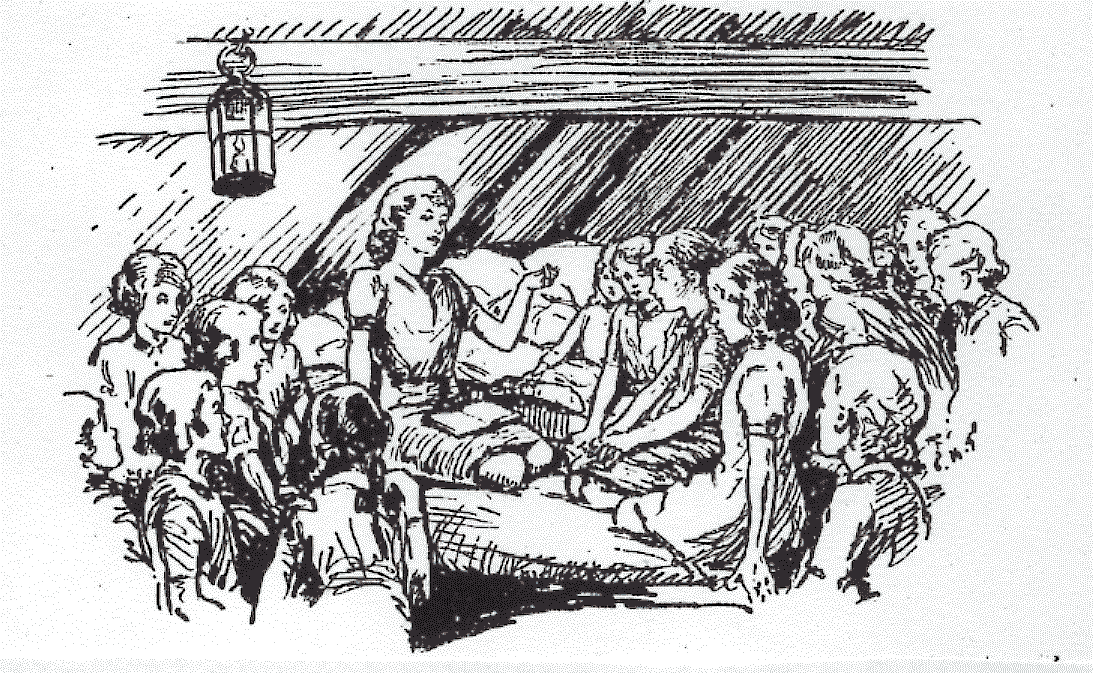
- by Christine D. Sprinck
[Excerpts]
[...]
 Of special interest is the formation of schools in Weihsien prior to the arrival of the Chefoo group. The head of the Education Committee had previously been with the Tientsin Grammar School. The committee organized the children into groups. At the pre-school and kindergarten age, there were approximately ninety students who were then divided into age-appropriate groupings from three to six years old.
Of special interest is the formation of schools in Weihsien prior to the arrival of the Chefoo group. The head of the Education Committee had previously been with the Tientsin Grammar School. The committee organized the children into groups. At the pre-school and kindergarten age, there were approximately ninety students who were then divided into age-appropriate groupings from three to six years old.
On the elementary level, two schools evolved.
The American School derived its staff from the Peking American School and the British School was made up of teachers from the Tientsin Grammar School.
The two schools went from grades one through eight, or the comparable Forms on the British side. They had one hundred students and sixteen teachers between the two schools. At the high school level, there were approximately fifteen teachers and seventy-five students in the British and American schools.
Adult education also thrived. “Amongst the Catholic Fathers, the educationalists from the Peking universities and the language students, we had some of the finest intellects in North China, and lectures and talks were given on every imaginable subject.” Ninety teachers taught more than 700 students in twenty-five subjects which included art, botany, ornithology, physics, chemistry, Chinese, French, German, Spanish, Russian, Japanese, Latin, Greek, philosophy, psychology, theology, commercial subjects, vocal and theoretical music, and higher mathematics.
[excerpt]
For the Chefusians, however, Weihsien was a God-send. “ The School entered a camp already in working order, and it was a measure of relief to the staff to feel that some of the responsibilities of Temple Hill would now be shared by the various departments of the camp’s administration ....
Cooking, which had been an increasing burden at Temple Hill, no longer fell upon the womenfolk. The repatriation also necessitated the reorganization of the camp schools. There were still four schools, the nursery, the kindergarten, the Weihsien School and the Chefoo School.
The Weihsien School was a conglomerate of the former American and British Schools. Since the Weihsien School used different textbooks, Chefoo maintained its own school and did not take in any Weihsien students. Some of the Chefoo staff, though, did teach in the Weihsien School. The Chefoo faculty had a staff meeting where, “after computing the least number for the running of the School, it was decided.
. . .
Those free from other official camp duties were able to organize classes so that at least half a day’s schooling was done (...) in dormitories.”
The staff also decided to continue preparing the students for the Oxford Examinations as “an incentive to steady work with a definite objective .... The effect on the whole school was noticeable .... The reintroduction of half-term marks was a further spur to industry, and a means of checking the progress of individuals.” The Chefoo staff had prepared for the continuation of schooling during internment by having students bring a complete set of textbooks for their year which were then passed down during the next three years to younger students. So the Chefoo School was able to function in cramped conditions and despite a “desperate shortage of paper.
Work would be done in pencil, erased, and the sheet of paper used again.”
Once the Chefoo contingent had settled in, Weihsien life took on a structured routine. “Roll Call- 7:30 a.m., Breakfast- 8:00, Tiffin [lunch]- 12:30, Super-6:00, Lights out- 10:00 p.m.”
Meals consisted of bread and tea, sometimes millet, for breakfast, stew for lunch, and soup for supper. This was supplemented with eggs from the black market, vegetables from small gardens and milk for the infants from cows kept near the camp.
The most glaring deficiencies were in “calcium, vitamin B, vitamin C and calories .... To attempt to partly meet the calcium needs of small children and adolescents, we are grinding up egg shells and feeding this, [but] the supply of egg shells is itself wholly inadequate.” In between meal times everyone did their assigned tasks to keep the camp functioning.
In the evenings there were recreational activities, adult classes, lectures, debates, plays, religious meetings, and concerts. “The aim of the camp was to have one entertainment a week ....
These, whilst being a strain in a way was quite a relaxation from work.”
Those with comfort money could make limited purchases at the canteen, and all could swap goods at the internee organized “Camel Bell Exchange.” Beneath this placid exterior there existed a black market, passing of secret messages to the outside world, and the plotting of an escape from Weihsien.
[excerpt]
The interned children were also involved in Boy Scouts, Girl Guides, and Brownies. While waiting in roll call lines the children would practice their “semaphore and Morse code messages.” They would earn scout badges for being able to build a fire and cook something in “tin cans [made] into stoves where you’d make a little opening with twigs underneath. These were big deal type things.
They even set wilderness trails where you had to follow like markings,” within the confines of the camp.

[excerpt]
Though the internees realized the importance of recreation for maintaining a healthy mind, body and spirit, there were concerns for the health of the children who were not getting adequate nutrition.
Some of the children had teeth coming in with improper enamel covering because of the inadequate food. On the rare occasions when eggs could be obtained at the canteen or from the black-market, the teachers saved the egg shells, dried them, “wound them and made us eat ground egg shell to keep the calcium.
We also got peanuts. We’d grind them on a hand grinder and make our own peanut butter.”
Although Mary did not have any problems with her teeth, she did suffer from severe asthma while in the camp.
“It was agony for me. The kids would complain that I snored. I would try to keep awake until everyone would fall asleep so I wouldn’t bother them.” Once she left the camp, though, her allergies subsided. Mary claims no long-term ill health effects from being interned and feels that overall her family has been “blessed with good health with the exception of Kathleen. She died of lupus six years after we got out of the concentration camp.
Was there any connection to that?
I have no idea. Doctors don’t know how people get lupus.” The lack of appropriate nutrients and caloric intake caused other problems as well, especially with menstrual periods. Most of us were delayed because of the nutrition level.
These British spinster teachers certainly did not discuss these matters with us. I had never heard of having a menstrual period. That was not anything the teachers talked to us about and I have a feeling that was one of the reasons we were kept in separate dormitories.
My bed was right next to Sandy’s and toward the end of the camp there some secret thing that every month Sandy got taken aside, hushy-pooh with the teachers and whatever it was we had no idea. I didn’t even know where babies came from. When we were in Chefoo before the war my sister surreptitiously wanted to know if I knew where babies came from and I had no idea. I had no idea when I got into the concentration camp, but all of a sudden Sandy had something happening to her that the teachers would take her aside. . It wasn’t until after we were out of the concentration camp I got fattened up with decent food that I started my period and my sister told me what had happened. Here, one girl started her periods before we got out. I think we were all retarded in our physical growth and development.
[excerpt]
The internment provided the Chefoo siblings an opportunity to see each other more than they would have if they had stayed at the Chefoo School. At the Chefoo School, siblings traditionally only interacted with one another on Sundays during “family time” when they were allowed to walk home from church together.
We saw [our siblings] much more in the camp. When we all got put in the hospital building [dormitory] I didn’t see Johnny as much because he was still housed in block 23, whereas Kathleen was on the same floor as I, and Jamie was one floor up. Our roll call was together. We didn’t have classes together, but we would have hymn sings together.
Mary interacted enough with her sister Kathleen to know of her sister’s crushes which Mary still talks of with schoolgirl secrecy.
I’ve got to tell you a secret. The older girls were beginning to have love affairs, my sister Kathleen was one of them. She was in love [and] even engaged to be married with Dougie. He was a 6’ 6-1/2” brilliant athlete, and really a lovely person and that was, of course, terrible because he was not Christian as we knew it, [was not a Chefoo boy].
Although the siblings were able to interact more, classmates and peers were still the most significant relationships as they would have been at the Chefoo School. “The primary group was our classmates. The people that you were really close to were our dorrnmates and then the boys and girls that were in our class together.”
[further reading]

http://www.weihsien-paintings.org/ChristinaSpink/index.php
#








